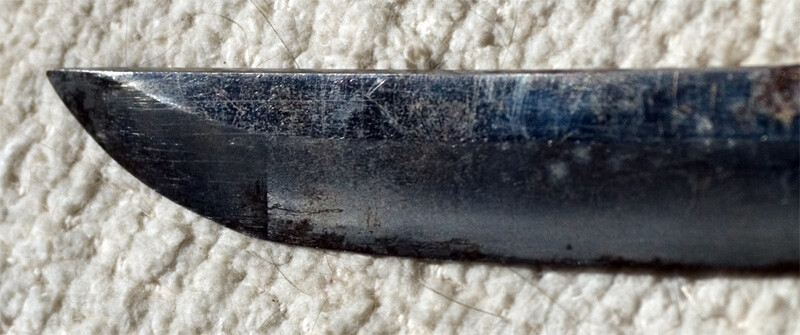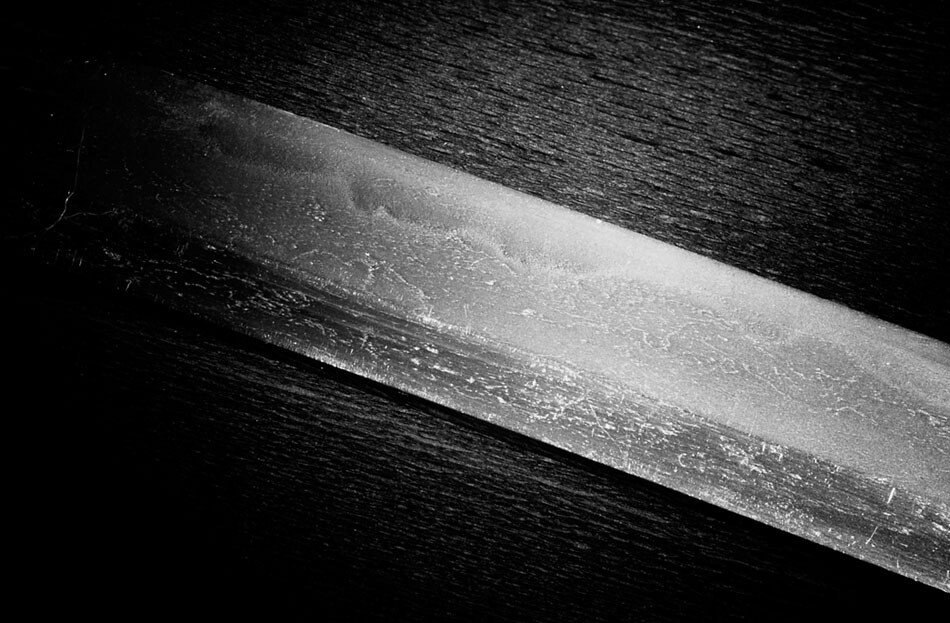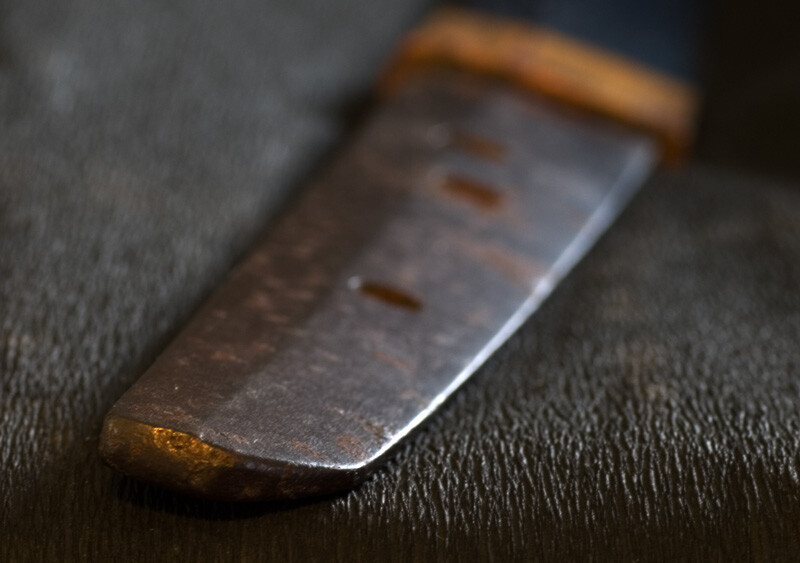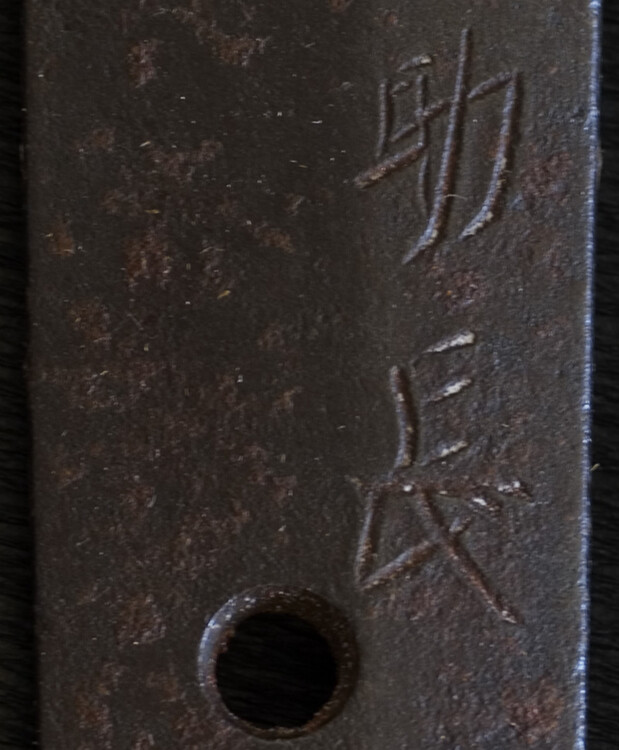-
Posts
108 -
Joined
-
Last visited
Everything posted by Roland
-
Dear NMB fellows, this time I would like to present you something which seems rarely to be seen in nihonto – a moroha tantō with a 7 inches nagasa. I must admit that I took some risk in acquiring this artefact. But finally the high quality of the blade with its blueish glimmer and the extremely fine and detailed engravings of the koshirae did entrap me. Plus a nakago with deep black rust of the wet look which for me seems to be typical for a very old steel. Because I have learned to judge a nihonto not by its mei but by its sugata and the feeling the workmanship creates in my amateurish mind I tried to ignore the mei on the dagger's blade. It reads: KO-KAJI MUNECHIKA SAKU On the opposite side of the blade there is a dragon horimono, likewise executed in a highly sophisticated way. So now it is up to you much more experienced nihonto-addicts to comment. Or to critisize my quite emotional new acquisition – by the way from a militia-dealer and -collector...
-
Not an easy language either, britch
-
Hello Ludolf, nice to meet you. My informations about the Kyo Go Kaji and Mishina School say that the 3rd generation Kinmichi received the Iga no Kami title in 1684 and was the first of the Kinmichi who used the "Mune" kanji instead of the "So" kanji in the Nihon Kaji Sosho... like seen in the mei above. But well, we all know The only detail I find a little bit doubtful is the chrysanthenum, especially the right to left stroke of the petals instead the left to right stroke of the 1st and 2nd generation Kinmichis. Though I haven't yet seen the original mei of the 3rd gen. Kinmichi on a nihonto. May be he turned from left to reight to the opposite direction?
-
Hi Jos, must have been a very decent guy, this Kinmichi... Just kidding... I know perhaps that he got the title from the emperor because of the arrangements he made to produce one thousand tachi for Tokugawa Ieyasu's war Thanx a lot for your kind help!
-
I just have seen a two-sided mei plus a Kiku mon. And this time I tried to decipher it myself. I hope I have made my homework now... For me the mei beneath the 16 petals kiku mon reads: Iga no Kami Fujiwara Kinmichi But the mei on the opposite side of the nakago, oh man! Possibly kanji for nenki? I'm not able to read it. I know, You guys with your enviable knowledge will smile and say "well..." Hm, it is really tough to be addicted to nihonto... Edit Brian: - Adjusted brightness for clarity
-
You guys are great. And I am ashamed! Stephen, yoy are right: At first I should have tried to decipher the mei myself. I know the sources... Next time I'll first invest some sweat myself :-) @Brian: I bow in humble adoration (didn't Elvis sing that?) and again realize how much I still have to learn...
-
This is a seven kanji mei on the ubu nakago of a katana. I would appreciate Your help with translation very much, dear fellow nihonto addicts.
-
Have a look, guys, at this ebay offer: http://cgi.ebay.com/NBTHK-FOR-UDA-KATANA-NO-TSUBA-OR-SWORD_W0QQitemZ160156525877QQihZ006QQcategoryZ73466QQssPageNameZWDVWQQrdZ1QQcmdZViewItem Isn't that strange? Where do this papers come from? Which owner would voluntarily pass on the papers of his nihonto?
-
Hm, sounds like a question a sword smith should answer? I don't know of a nihonto-term describing such a virgin nakago. By the way: welcome, Torsten! (Just in case it is you...)
-
Unbelievable! I have never before seen something like this
-
Hi Henry, I have this gimei-feeling too, quite instinctively. But I have no problems with the positioning above the lowest Mekugi ana if it is a slightly shortened Tachi?
-
What do You think? Is this a Sukesada Wakizashi from the Bizen tradition during the Muromachi period, Eisho (1504-1521), possibly mass-produced for war like many blades during this time? Or a later Shinto piece? Hm, the Yasurime ("Hawk's feather") style of the nakago was often seen on Yamato province blades...
-
You guys have sharp eyes! Indeed the ito is broken. One further task for the restoration project.
-
Hi Stephen, well, on one hand here in Germany still a lot of GIs are in service. Several of them have brought father's "family souvenirs" with'em. So from time to time there ist a chance to see a interesting piece of nihonto (plus lots of junk!). On the other hand there still is ebay. And yes I know about the risks!
-
-
Here You see the Mune near the yokote and some details of the Koshirae: fushi, kashira and menuki (Shishi lions)...
-
It is saturday, the sun is shining and I am shooting some further photos of the Sukesada-Waki. Guys, I must be crazy Here we go...
-
I'm not absolutely sure, but there seems to be one line of Suji-utsuri along the hamon???
-
I have done a quick shot with the Nikon. Without any perfection and just to show the Sukada of the Waki. Later I'll add some better (lighted) photos. @Darcy: Nice to meet you again! In the meantime I have received your Bizen-book. Hmmmm... great stuff and extremely helpful for my studies. Thanx again for this spectacular stuff! SUKESADA? That was my first impression too after some Photoshop-work, though I'm by far not as experienced as you to be sure about my impressions. The Waki came with a black laquer saya of poor condition and a really nice set of iron tsuba (mid to late Edo, Shoami style, mokko gata, inlaid shakudo w/gold or brass, silver, possibly Hamano school) fuchi and kashira. From these I'll add photos later too...
-
I'm not sure about it. I'll have a look for utsuri later this day.
-
Very interesting findings indeed! Because of the just two kanji signature I was not sure about the Goshu Gamo ju Sukenaga but he is quite interesting because he was one of the smiths who imported Bizen-style to the provinve of Omi... I won't over emphazise the mei though. Nevertheless Moriyama sans and Brians observations sound quite logical. Another question: Sounds as a polish could be useful? I'm also thinking about a matching koshirae. Would it be worth the trouble?
-
Another find :-) A Wakizashi, unrestored, but with some quite interesting potential... My problem is that I'm not sure about the two kanji of the mei. So if anybody of the more experienced posters of this fine board has an idea, please don't hesitate to share Your knowledge! Nagasa: 18.5" / 47 cm Nakago: 6.5 " / 16.5 cm Length o.a.: 25" / 63.5 cm Sugata: Shinogi-zukuri Sori: 1.4 cm Mune: Iori (gentle ioshi) Width mune-machi: 2.9 cm Thickness mune-machi: 0.7 cm Thickness Yokote: 0.35 cm Tang type (nakago): Futsu, ubu Mekugi-ana: 1 Nakagojiri: Haagari Yasurime: Takanoha "Hawk-Feather" Mei: 2 Kanji: ? ? Kissaki: chu-kissaki Boshi: (not yet identified) Hamon: Suguha
-
Some more photos... One of the Nakakojiri and one contrast-optimized photo of hamon, jihada and hataraki. Quite tricky to shoot. This time I used a digital Olympus E-330 with adapted manual Leica Macro-Elmarit R for the details. Only the lighting still isn't perfect Still learning here too... And one further photo of the whole blade, both sides, without the mounting. I hope one can see the hamon...
-
Thanx a lot, guys, You are really helpful! For Yamato the shinogi should be higher than that what I can see here... Bizen? Hm, that's a point... May be a Kozori smith would fit quite well the style of the blade... shallow sori, a sugata which is thinner and smaller, with temper lower... I will have to investigate this! Well, and here are some better, sharper photos of the nakago plus a close-up of the mei/gimei...


























